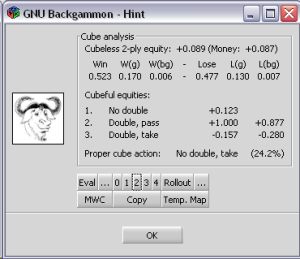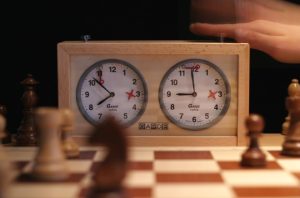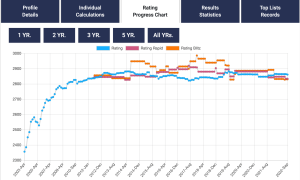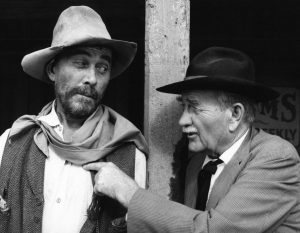tl;dr: There is cheating in chess. Talk about it, deal with it, but have a sophisticated, stringent game plan before the party starts!
Disclaimer: For nearly 20 years I worked as an IT professional. I play club-level Chess, my highest Elo was close to 2200. I dealt with cheating issues while organizing local and regional Chess tournaments online during Corona. Around 15 years ago I was engaged in developing a cheating detection system for Backgammon hosted by a big game server. I don’t claim that I played Backgammon world-class level. But at least I reached the semifinal twice in the world championship and knew a little bit about how to fiddle around with checkers and cube.
I was also a member of the Gnu Backgammon crew, an Open Source follow-up to Jellyfish and Snowie, based on a neural network which – similar to Alpha Zero or Leela in Chess nowadays – put the game of Backgammon on a completely new level 20-25 years ago. But unfortunately also made it more likely that some people used neural network Backgammon software for cheating online. Even at the top level. As you can see, the Backgammon world faced the problem of cheating already two decades earlier. And there are a lot of parallels to the Chess world.

As English is not my native language I have to apologize for countless mistakes. I will correct them in case you point me to them. The article is also very long, sorry for this. But I have seen too many misunderstandings regarding the unpleasant world of cheating. My attempt was to write something the average chess player is able to follow. It’s still complex, so there is a lot of text and only a few fancy pictures but it hopefully sheds some light on this unappetizing subject.
For those who expect a concrete solution, result or verdict regarding an issue, which is heavily discussed and speculated among Chess players at the moment, I have a disappointing message right at the beginning: There is none, at least no perfect one. You can’t catch them all. Deal with it! But you can help to make the chess world better.
The elephant in the room
First and foremost we all – Chess players online and offline, officials and organizers – have to accept an uncomfortable truth: There is cheating in Chess. Ignoring or – even worse – denying the elephant in the room doesn’t help. Countless sports organizations tried this poor strategy over and over again. Remember swimmers, cyclists, or heavy-weight lifters. You better should accept the facts and think about how to detect and diminish cheating.

The royal road is the educational approach. Make people not willing to cheat. Simple as that. Unfortunately this probably only works in a perfect world. So you have to implement sophisticated systems like in nearly all other competitive sports. More on this later.
100% certainty is rare in life
Another uncomfortable wisdom: Unless you don’t catch a game cheater «in flagranti» there never will be 100% evidence that someone is cheating. At least there will be no absolute certainty Chess players usually like to see and argue with. Nonetheless, you can calculate or estimate mathematical confidence whether or not someone is cheating. And you can develop a strategy to act accordingly.

In Backgammon – also a strategy game, but with a luck factor – we differed between quantitative and qualitative factors for detecting cheaters. Though I have no secret insights I assume that the current systems at least for Chess servers are built in a similar way. I will not talk about the special case of using electronic equipment in live games here, this would lead too far. But for the sake of arguments let’s assume this happens and is not found always by standard detectors.
Quantitative factors
A simple quantitative measurement as a first filter is to compare moves. No rocket science and well known nowadays. Like we did in Backgammon you can build reference groups for certain ratings and different time controls. Disadvantage: the higher the real playing strength of someone is, the less this simple tool will work. And nowadays only idiots will play ten perfect «Stockfish» games in a row while their rating is around 2000.
Online – and sometimes also for live games – there is another easy measurement: Investigating the time usage during games. This is also simple and well known. But again, only a dumb ass will need exactly five or ten seconds each for forced moves, obvious trades or the first moves in the opening.

Nonetheless you probably still catch an astonishing amount of cheaters this way. A time-saving(?) approvement is the implementation of a neural network like Lichess did with Irwin. Though Irwin does a little bit more than just checking moves and time usage.
Also easy to measure in online Chess but not that well known are things like mouse movement, switches between tabs and windows, or checking the process list of a device. Some people might wonder how much their internet browser, their Android app or their operating system is voluntarily revealing. And of course, we are entering regions now, which are – at least ethical or even concerning the laws – doubtful if not forbidden.
Apart from using an opening database these are more or less all pure quantitative aspects I know today. You measure them, you build reference groups, you compare, develop algorithms and decide more or less automatically. Small improvements in these systems are invented by people like Ken Regan, just google the name combined with the words chess and cheating.
The mixed zone
We are now reaching a mixed zone between quantitative and qualitative criteria. When we developed a system for Backgammon we also tried to measure the complexity of a given position. I assume this is easier to implement for the dice game than for Chess.
Keeping GTO-based decisions aside the two main criteria in Backgammon for complexity are certain score differences in matches and the amount of your own checkers which still have contact to the opponent’s checkers. Generally speaking, the more contact the more complex is the checker play. The more unusual a score is the more complex certain cube decisions.

If I remember correctly there were or are similar approaches for chess. My educated guess is that a well-trained neural network should be a big help here. And, who knows, there might be already a working system on the biggest commercial chess server checking this. Difficult to say as long as these systems are black boxes for outsiders.
Complexity can also be measured by the number of critical decisions during a game. If I remember correctly, former Chess World Champion Vishy Anand once said that in an average game he has to make only around five decisions, the remaining moves are opening preparation, forced or pure technique. Of course, it is much easier to recognize critical decisions if you are a top-level player. The average club player might be unsure in more than half of the moves because of his lack of knowledge.
At least there is one thing you can do if you aren’t an AI hero or World Champion: ask an expert (GM/IM) how likely it is that a player of let’s say 2000 Elo is capable of finding a certain and deep tactical idea or a strategical plan in given positions. His experience will not always but often be very helpful.
Combine the aspect of complexity with the time usage and you are one step further.
Rating development

An underestimated but still measurable long-term detail is the rating development of a (Chess) player. Whether you are a world-class player or «only» semi-professional, whether you started playing Chess at the age of 8, 18 or 58, whether you are a «prodigy» or a hard worker or both, there are typical trends and progress which can be compared and investigated. In cycling races the officials are regularly measuring the wattage of a cyclist based on his weight. And believe me, in case a certain world-class cyclist increases his wattage suddenly by an astonishingly 15-20% during the stage up to Alp d’Huez he probably has to explain a little bit.

For every long-term deviation of a typical curve there must be an explanation. «My rating went down 150 points? Oh, I have a wife and two children now». «I made a jump from 1800 to 2200 within 18 months? I’m 16 years old, take Chess more seriously, get lessons from a FIDE master». The bigger the jumps are at a higher level, the more explainable a sudden jump should be. Under normal circumstances getting from 1200 to 1600 as a child is much easier to accept and explain than if I jumped from 2100 to 2500 at the age of 58. And don’t forget: the closer you get to the summit, the thinner the air is.
You can measure and compare rating development (quantity) and also give a reasonable explanation (quality) in most cases. In some you or the affected player can’t or is not willing to explain. It’s up to the officials then to draw their conclusions, see below.
Qualitative investigation
A pure qualitative criterium is to investigate explanations regarding circumstances, preparation, moves or results. You need inside knowledge in this case. You play at or have regularly contact to people at a certain level. The Backgammon circle is not that big compared to Chess. Gamblers know each other better. So they are usually aware what strengths, weaknesses and general behavior other players have. Some have a photographic memory, some can do calculations lightning fast, some are known for being good at matchplay but worse at money game.

During a sophisticated interview you pretty fast get aware of whether a player was «in the game», made decisions based on concrete calculations or has reasonable explanations. I assume – at least from what I see in public interviews after tournament games – this is more or less the same at top-level Chess. Just think of Anish Giri, who rattles down complicated lines when asked to a certain move. Or Yasser Seirawan who is able to explain games and plans even at club level. Just to give you two examples.
I always become attentive after sentences like «This is obviously the right move, don’t you see it?» throwing the ball back to the interviewer without going into details. Or «I played this and this and this because it just felt right» pointing to the famous intuition. Occasionally and for certain players this might be understandable. But not in all cases. Backgammon is a concrete game with nearly full information and so is Chess at least in tournament games. I guess you got the point here.
And now?
So, in the end, you have some objectively measurable facts based on solid collected data. All were examined and classified by experts. You also have some qualitative information. What now?
The bad news is: as long as you don’t secure the «smoking gun» you still don’t have 100% evidence. Never ever! The good news is: there is something you can do.

As an official, organizer, arbiter or chess server operator: Have a proper game plan before the party starts! Don’t ignore the problem of cheating. Measure or at least guess the confidence of a possible cheating case. Whether it is «only» 70% certain or 99.999%, develop a strategy based on quantitative and qualitative collected data. You can then act responsibly and accordingly. Don’t forget that you are in debt to all other players, too. Keep also in mind to adjust your strategy on a regular base. We live in a fast developing world.
There is – similar to other sports – still a kind of self-made problem to solve. And this won’t be that easy. «It’s improper to talk about a suspicion in public!» Or «don’t pull our beloved Chess sports into the dirt!». Gladly taken also «Don’t damage the image of a chess player in public». Familiar with? Wrong in my opinion!
We have to accept the reality. We have to dare asking uncomfortable questions. And, players have to accept that they are sometimes confronted with these questions or suspicions nowadays. As we had to accept leaving smartphones out of the tournament area. Because cheating is not only possible but already happened at lower and higher levels. Online and offline.
Last but not least and also not easy to deal with, but more of an educational asset: opponents and spectators all have to get into their minds that suspicion is not a verdict or decision. Rumors or a perfect, shorter game here and there, a surprising victory or a tournament win as an underdog doesn’t mean cheating at all.
«Innocent until proven guilty» is valid also for Chess. And thanks for staying to the end ;-).
[Update 06.09.22: I forgot to mention an important detail. It’s absolutely necessary that all responsible people act in a common, stringent way. This regards quantitative analysis and consequences as well as qualitative. In a perfect world this is coordinated by an umbrella organization, but well… ]
